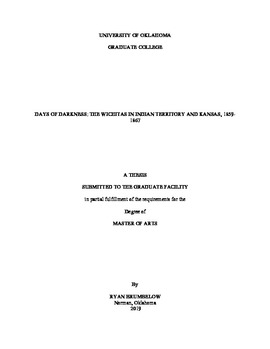| dc.description.abstract | Most of what is known about the history of the Wichita peoples is scattered throughout the works of historians Earl H. Elam and F. Todd Smith, as well as anthropologist W. W. Newcomb, Jr., leaving this historiography of the tribe relatively short. Though the Wichitas appear fleetingly in the works of other historians, little has been done to build upon the works of Elam and Smith since they wrote their comprehensive histories of the tribe in 1996, 2000, and 2008 respectively. All three of these works (one by Elam and two by Smith) are relatively short and contain only brief descriptions of the tribe during the period of the Civil War. Muddying the waters further is the fact that accounts of the tribe during the aforementioned period are conflicting, particularly in concerns to how the tribe spent their time in Indian Territory following their removal from Texas as well as their brief stay in Kansas throughout the duration of the war.
This project intends to correct this array of issues. It will do so by presenting a clear narrative that encompasses the Wichita peoples’ time spent in Indian Territory, including a clearer presentation of the factors that led to their removal from Indian Territory to Kansas around the outbreak of the Civil War. The factors include abandonment by the Union, a failed relationship with the Confederacy, failure to produce crops that could sustain their population, and hostile neighbors in the form of Union-allied native bands and old enemies from Texas. The combination of these conditions led Confederate soldiers to march the Wichitas north to Kansas, where they were essentially abandoned by both warring governments. This project will also encompass their time in Kansas and will detail how the negligence of both governments, combined with failed agricultural ventures, a terrible flood season, and rampant disease, led to the sharp decline in the tribe’s population before they returned to Indian Territory in 1867 following the conclusion of the war. | en_US |
